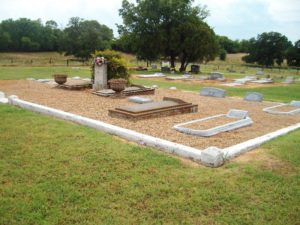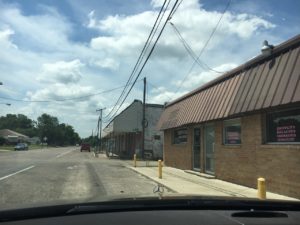
Grave of Clarence A. Glass in Lone Oak, Texas. Glass was killed by a lone robber on the night of December 8, 1916. Glass was Cashier at the First National Bank in the neighboring community of Point. Working late auditing the bank’s books, Glass was shot in the back of the neck. No one was ever charged with the murder. (From Findagrave.com)
On the evening of December 8, 1916, an unknown assailant fatally shot Clarence A. Glass in Point, Texas. More than a century later, the murder still remains unsolved and probably long since forgotten.
The First National Bank of Point employed Glass as cashier. Reportedly he was a responsible young businessman of “worth and promise” according to the December 15, 1916 issue of the Greenville Messenger. Why he was at the bank that night is unknown. Perhaps he went to the bank to write a condolence letter to Rev. S. E. Luker as the Messenger reported or perhaps he went to examine bank records for any misappropriation of funds as his wife believed.
While consumed with his project at hand, Glass realized an armed, masked man stood behind him demanding money. With the time lock on the safe engaged, Glass could only give the assailant petty cash valued at approximately $300. The masked man shot him in the back of the neck three times before vanishing. Glass regained consciousness later and made his way to the nearest residence. There he told what occurred at the bank. Immediately he was given medical treatment and his wife Ray Etter Glass who was in Lone Oak visiting her parents quickly returned. Around three o’clock the following morning Glass succumbed to death, leaving a young wife and daughter.

Downtown Point, scene of murder of Clarence A. Glass. In the last 100 years, buildings were razed to make room for Highway 69.
Immediately citizens of Point and neighboring towns raised a $1,000 reward as they set off to discover the culprit. Within days authorities, including Will Thornton of Point and Joe Humphreys of Greenville, arrested Chas Carter, a young man who lived near Point. Carter had in his possession a pistol with an empty chamber. Carter claimed he borrowed the pistol to hunt squirrels. It matched the caliber of the murder weapon but the evidence was circumstantial at best. The Rains County Grand Jury did not convict Carter and the investigation began again.
At this point much of the evidence is completely missing. From what is available, it seems that Carter was released for lack of evidence. Then, J. W. Bergen was arrested in Louisiana in December 1916. He was held in Emory until May 31, 1917 when he was transferred to the Greenville jail after the Rains County special grand jury was discharged without a bill of indictment. Bergen stayed in the Greenville jail until tried in Rains County in December 1917.
The trial was continued until May 1918 when most witnesses did not show for various reasons. Bergen claimed to have been in Anderson County on the night of the murder, riding the International and Great Northern Railroad to Shreveport. Another witness was P. R. Schumacher, a detective/manager for Burns National Detective Agency in Dallas who investigated the crime. He was hired by the young widow and expected to testify that some other person committed the crime.
At the trial in May 1918 all but two witnesses were present. Two Point residents were ordered to bring a box found recently in a creek near Point. After a long deliberation the jury found J. W. Berger not guilty as he had pleaded the whole time.
Was the culprit found and punished? No, although Ray Etter Glass would spend the rest of her life trying to find the murderer. She believed that someone in the bank guilty of the misappropriation of funds hired the young man who killed her husband. She believed her lawyer and the detective knew more than they told her. Unfortunately, the assailant was never found and Ray Etter Glass found no earthly peace.
